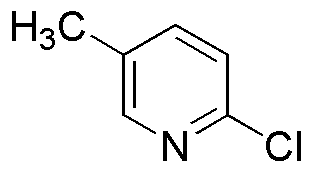2-Chloro-5-methylpyridine is widely utilized in research focused on:
- Synthesis of Pharmaceuticals: This compound serves as an important intermediate in the synthesis of various pharmaceuticals, particularly in the production of anti-inflammatory and anti-cancer agents.
- Agricultural Chemicals: It is used in the formulation of agrochemicals, including herbicides and fungicides, helping to improve crop yield and protect against pests.
- Flavor and Fragrance Industry: The compound is employed in the creation of specific flavoring agents and fragrances, enhancing the sensory profile of food products and perfumes.
- Research and Development: In academic and industrial research, it is utilized as a building block for developing new materials and chemical compounds, particularly in organic synthesis.
- Analytical Chemistry: It is used as a standard in analytical methods to quantify and identify other compounds, ensuring accuracy in chemical analysis.
General Information
Properties
Safety and Regulations
Applications
2-Chloro-5-methylpyridine is widely utilized in research focused on:
- Synthesis of Pharmaceuticals: This compound serves as an important intermediate in the synthesis of various pharmaceuticals, particularly in the production of anti-inflammatory and anti-cancer agents.
- Agricultural Chemicals: It is used in the formulation of agrochemicals, including herbicides and fungicides, helping to improve crop yield and protect against pests.
- Flavor and Fragrance Industry: The compound is employed in the creation of specific flavoring agents and fragrances, enhancing the sensory profile of food products and perfumes.
- Research and Development: In academic and industrial research, it is utilized as a building block for developing new materials and chemical compounds, particularly in organic synthesis.
- Analytical Chemistry: It is used as a standard in analytical methods to quantify and identify other compounds, ensuring accuracy in chemical analysis.
Documents
Safety Data Sheets (SDS)
The SDS provides comprehensive safety information on handling, storage, and disposal of the product.
Product Specification (PS)
The PS provides a comprehensive breakdown of the product’s properties, including chemical composition, physical state, purity, and storage requirements. It also details acceptable quality ranges and the product's intended applications.
Certificates of Analysis (COA)
Search for Certificates of Analysis (COA) by entering the products Lot Number. Lot and Batch Numbers can be found on a product’s label following the words ‘Lot’ or ‘Batch’.
Numéro de catalogue
Numéro de lot/série
Certificates Of Origin (COO)
This COO confirms the country where the product was manufactured, and also details the materials and components used in it and whether it is derived from natural, synthetic, or other specific sources. This certificate may be required for customs, trade, and regulatory compliance.
Numéro de catalogue
Numéro de lot/série
Safety Data Sheets (SDS)
The SDS provides comprehensive safety information on handling, storage, and disposal of the product.
DownloadProduct Specification (PS)
The PS provides a comprehensive breakdown of the product’s properties, including chemical composition, physical state, purity, and storage requirements. It also details acceptable quality ranges and the product's intended applications.
DownloadCertificates of Analysis (COA)
Search for Certificates of Analysis (COA) by entering the products Lot Number. Lot and Batch Numbers can be found on a product’s label following the words ‘Lot’ or ‘Batch’.
Numéro de catalogue
Numéro de lot/série
Certificates Of Origin (COO)
This COO confirms the country where the product was manufactured, and also details the materials and components used in it and whether it is derived from natural, synthetic, or other specific sources. This certificate may be required for customs, trade, and regulatory compliance.


